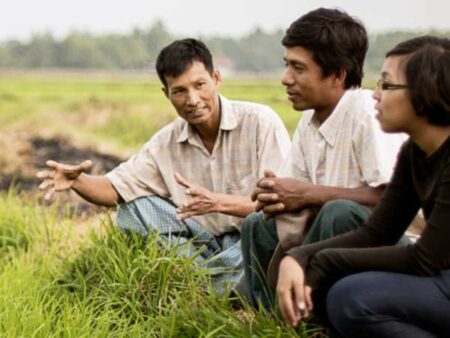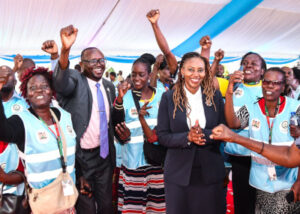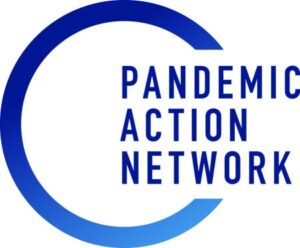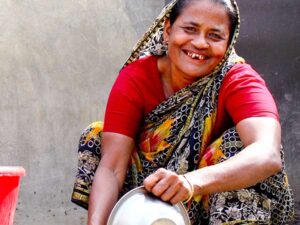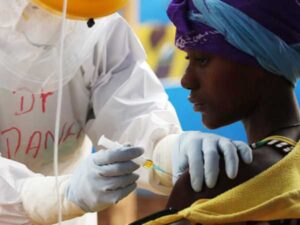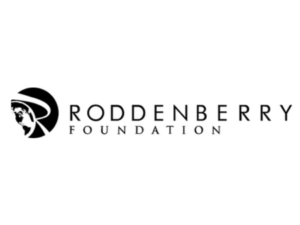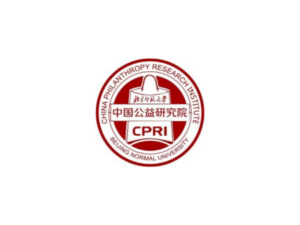Proximity Designs brings low-cost, high-impact products and services to farmers in Myanmar using human-centered design principles.
Debbie Aung Din of Proximity Designs spoke with Lissa Harris on February 20, 2023. Click here to read the full conversation with insights highlighted.
Lissa Harris: Can you introduce yourself and your project and talk a little bit about the problem that you are working on?
Debbie Aung Din: I’m Debbie Aung Din and I’m co-founder of Proximity Designs. We work with smallholder farm families in Myanmar, and we design, create and deliver farm solutions or products and services that will help farmers be more productive and increase their incomes and wellbeing. Most of the products and services are also to make them more sustainable in taking care of their soils and natural resources.
Lissa Harris: Do you work directly with farmers, like a direct service organization?
Debbie Aung Din: We design innovative and affordable products and services that aren’t available in the market or where the government is not providing it. Then we introduce those into the market and promote them in villages and with farmers and stimulate demand for them. Then other local companies and suppliers will want to come in and supply them as well. As a social enterprise, our role is to fill that gap where the government and the markets are not providing these essential services of products.
Lissa Harris: Can you get a little bit more specific about how farmers are benefiting from the work that you do and what the services are that you’re providing to them?
Debbie Aung Din: The three main areas are, number one, we have efficient small plot irrigation products systems. Those would be like we introduced drip irrigation, but it’s very affordable, a fraction of what it would cost in the states or other countries. There’s also misters and sprinkler systems and water saving devices that help farmers irrigate more efficiently. They save time and water. The other area is pest and disease prevention services and products. Some of these are actual biological pesticides. There’s a sort of a crisis in Myanmar because of an overuse and abundance of very toxic pesticides coming in from China and different parts. There’s no real regulation and farmers don’t necessarily have instructions in Myanmar language. So when pests and diseases appear, they just go to the shop. There’s not a proper diagnosis or treatment of it and it’s harmful for human beings as well as the surrounding ecosystem – ducks and crabs and whatever is around.
We are introducing biological pesticides that are nature-based and are much better all around – better for soils, better for the ecosystem, better for human beings. An example of this is a beneficial fungus called Trichoderma, which is a beneficial fungus that controls and attacks diseases of roots in plants, and it stimulates plant growth as well and makes very healthy root systems. Those are the kinds of products we’re introducing. We also provide diagnostic services. We have a call center where we field calls from farmers when there’s a pest and disease attack. We’re able to do agronomy like telehealth and affordably help farmers contain whatever pests and disease outbreak they have.
The third area is crop nutrition and soil health. This is foundational for sustainable farming, to be able to take care of the entire soil ecosystem and biodiversity that exists underground, [which is] a non-renewable resource, so we have to. We have to take care of our soils for future generations and for food security. We have soil health testing services and we have products that will help enrich soils and crop nutrition, to help crops grow in a more sustainable way.
Lissa Harris: Would it be fair to say you’re almost functioning like an agricultural extension program?
Debbie Aung Din: Oh, definitely. It’s not existent in Myanmar because the government has very little budget for it so farmers haven’t had extension services for quite a while. If there is a pest and disease outbreak, for example, they just go to the pesticide shops in town and there’s no independent resource of knowledge. They’re dealing with climate change every day and all kinds of these pests and diseases are related. They’ve never seen them or dealt with them before so they need access to an independent source of knowledge.
Lissa Harris: Is the local government supportive of what you’re doing because they don’t have the capacity to do this, or has that been a barrier for your work?
Debbie Aung Din: We had a military coup in 2021 and government resources haven’t been available for agricultural support. People in rural areas are essentially on their own. We decided to innovate and deliver extension services in a way that’s really farmer friendly and farmer focused, and that includes digital channels that are a lot more affordable as well as looking at how farmers learn from each other. We have farmer to farmer videos and we have farmer [digital] communities based on what crops they grow.
Lissa Harris: What is internet access like on the ground in that population, is it mostly mobile phones or are people able to access things on computers?
Debbie Aung Din: It’s mostly very inexpensive smartphones from China. Prior to the coup, internet access was fairly good and there was a lot of uptake, but now there’s more outages and control of the internet, and prices are rising. That has hampered our digital outreach, but it’s still a lot cheaper than in person delivery.
Lissa Harris: What makes your approach distinctive from other groups that are trying to tackle similar problems?
Debbie Aung Din: Foundationally, we focus on farmer-centered design and human-centered design processes. That is based on our name, “Proximity” to the customer. We apply rigorous design principles and processes to designing products and services, [the same as] design companies worldwide and in wealthy countries would apply to design products and services for wealthy customers. But we’re applying them to customers who make $2 a day. So there’s some design constraints, like affordability, convenience, and durability, but our customers also value aesthetics and convenience just like everyone else. We have a lot of constraints, but that is our process. Really zeroing in on iterative prototyping and getting feedback and involving farm customers in co-creating these products and services.
Lissa Harris: Is there an example you can share, whether it’s a project succeeding on a farm or some particular example, that illustrates the impact of the work that you do?
Debbie Aung Din: There are a million products and services that people who are struggling daily need and want, but we have to have a filter and decide which one to focus on promoting. We look at the benefit and the financial return to the farmer for using this product or service, for their farm productivity yields, increases, as well as incomes. If it’s around $250 net income increase per year, then we feel like it’s worth looking at. We also look at the scale of how many farmers it applies to and would be interested in it. It needs to be close to a million or so for us to be able to scale it, and have that kind of interest and invest in R&D.
So the impact is very important for farm incomes, first. It needs to make sense for the farmer, and we have a third lens, which is making sure it is climate positive in terms of enhancing soil carbon or reducing emissions. Farmers want to participate in being caretakers of the planet’s resources. They don’t want to be treated as victims that need this subsidy, they’re actively interested in taking care of their soils and natural resources sustainably for future generations.
Our irrigation products [have had a positive impact]. Farmers were hauling water to their fields by carrying heavy buckets of water on both sides, [making] 200 trips a day and watering by hand. You can’t get very far or grow that much, maybe a quarter of an acre at the most, and it’s grueling. Our [water] distribution [products], our misters and sprinkler systems and drip irrigation replace those sprinkler pans so that they not only save water, but they’re able to eliminate the drudgery and expand their plots to an acre – three or four times [the size] – which is a huge boost to income.
Lissa Harris: Is there a particular farm that you can talk about, an individual farmer’s success on that front?
Debbie Aung Din: Oh, there’s hundreds of thousands. We have this elderly couple, and they didn’t have any children so they didn’t have people who could take care of them. In their seventies they were still hauling very heavy cans of water to their fields, 40 pounds on each side. They could only grow a quarter acre of vegetables so they were really [living] hand to mouth, not to mention the burden on their backs and their health. They discovered our systems and they eliminated the watering cans and we’re able to just turn on a faucet with a drip irrigation system. Watering without the drudgery also freed them up to do other things, like go to the market and sell their produce directly and get better prices.
They were able to triple the acreage they could grow, so they feel much more confident of their future. [They feel] they can rest and enjoy their elderly years and not be under this daily drudgery of having to work hand to mouth. We have customers who say with the extra income – they’re able to double and triple their incomes – they can keep their kids in school without going into debt. They’re able to educate their kids. They’re able to invest in their farms and buy a cow or two and repair their roofs and things like that. Open a little shop in the village. It generates much more economic activity in the village as well.
Lissa Harris: Can you talk about what insights or what teachable lessons can be taken from your work that others could use? What could other people learn from the way that you approach what you do?
Debbie Aung Din: Most important for us has been to stay flexible and stay close to the customer. Things are always changing in the outside environment, whether it’s the economy or political events, there’s so much disruption in markets. You don’t get stuck on one formula and stick to it, you really stay close to what the customers want and need. And that means doing a lot of R&D and really listening and adjusting quickly, staying agile. That’s been really important for us and to not be scared to pivot our strategy.
Lissa Harris: How do you measure your success? What’s the evidence that you’re making progress and that you know which products and services you need to focus on?
Debbie Aung Din: Our main indicator is increased net incomes for farm families who use our product. We measure that first by tracking sales. Are there people buying it and interested in the product or service? Secondly, we do in-house and external assessments, surveys, with our customers to see what the impact is. [To measure] the difference between their incomes and the incomes of people who don’t use it.
Lissa Harris: It sounds like it would be on a longer timescale?
Debbie Aung Din: We have to design for immediate payback. The payback we design for is about a season, or less than a year, because a farmer’s [financial] timeline is very short. They don’t have the luxury of investing in something that they see the payback two, three years down the road. They need it this season. That’s the challenge for us, finding products and services that will boost their yields and productivity that season.
Usually, after the season, we’re able to go back and measure [impact]. Now that we’re interested in doing more with enhancing soil health, that might need longer longitudinal studies.
Lissa Harris: Sometimes with working on problems like this, you can learn as much from things that didn’t work as things that did. I’m wondering if you can describe something that you tried that didn’t work and taught you something important from that failure.
Debbie Aung Din: We try to prototype while it’s cheap, so that when it fails, it is not too much of an investment. We try to fail quickly. One of our first products was a treadle pump that farmers use, like a StairMaster for pumping water to the fields. Farmers always wanted a bigger volume of water for $25 and a piece of equipment.
We had a regular two and a half inch cylinder with our foot pumps. Since farmers wanted more volume, we decided to try a four to six inch pump with bigger volume. We made about 600 of them and put them out there. Clearly it was way too much effort to try to pump and treadle just to get that much volume out. Kids can use our standard pump, and they like using it. They think it’s fun to treadle on it. And women can use it easily. It’s really, really convenient to use. But when you get big volumes and a bigger size, then no one can use it, and it’s very slow-going. So we had to nix that.
Lissa Harris: This gets back to what you were saying about human-centered design and making sure that the design is right for the products you’re offering, as well as things like cost and profitability.
Debbie Aung Din: Right. And the markets are always changing. When something gets supplied in the market, then we feel like we don’t need to be there anymore supplying it because that’s not what we want to use with the grant money we receive.
We sold probably over 300,000 of the foot pumps. And at some point they peaked. What happened was the trade with China opened up and there were all these very inexpensive $70, $100 diesel pumps that came in. Diesel pumps used to be $300, and now these were $70 or $100, much more affordable, so people were not as interested in our foot pumps.
That’s when we pivoted and said we don’t need to be offering this product anymore. We also tried selling solar lanterns. We were the first to introduce them in the rural areas. People were using candlelight or these toxic diesel, kerosene, lamps to study. Solar lamps and lighting were not available so we started introducing it into the villages. Then, in about a year, the market was flooded with cheap solar lights from China so we said, well, we don’t need to anymore.
Lissa Harris: Is the funding that you get helping to subsidize the cost of some of this stuff to the farmers and the prices of products low? And then if the market is actually meeting their needs, you can say, “Okay, we’re going to move on to a different kind of product.”
Debbie Aung Din: If we were to fully load our costs like a business and charge a hundred percent to the farmers, the R&D costs, the marketing costs – rural marketing is expensive, promoting in the villages takes travel because they don’t see what’s in the urban areas – it would probably triple or quadruple the price of a product. The donors pay for the R&D costs that they subsidize in the marketing to introduce into the markets.
In terms of subsidies, there are lots of private companies around the world who receive government subsidies. For some of them, 50% of their income is from a government subsidy to promote a product that comes with a lot of social good, whether it’s solar or drip or irrigation, something good for the country. They want faster adoption so they will give government subsidies to companies. Similarly, we’re getting those kinds of subsidies from donors.
Lissa Harris: Setting aside the issue of funding, because funding is a challenge for every organization that’s trying to solve a social problem, are there other kinds of challenges or barriers that you haven’t yet been able to overcome in terms of either scalability or opposition like in communities or political opposition, public reception, accessibility, kind of large scale challenges that you’re still working on overcoming so that you can get to the next level?
Debbie Aung Din: Myanmar is at a very complex nexus right now of extreme poverty, political conflict on the ground, migration and inequity as well. We have multiple crises, not to mention climate change too as a daily threat, it’s a huge challenge to operate and to design for that environment.
It’s probably an extreme lab, “If it works Myanmar it can work anywhere,” sort of thing. When you’re dealing with people with very low incomes, adoption takes quite a while because they don’t have disposable income. That process takes a long time. For us, [one challenge] is how can we speed up that process when they don’t have access to finance, don’t have access to the normal things that consumers in wealthy countries have and that would allow them to adopt these things.
Lissa Harris: We talked a lot about the benefits that farmers are getting from your program, but stepping back, looking at it from a broader perspective, can you talk about how you’re working to advance system level change in this area and how you’re going about doing that?
Debbie Aung Din: In Myanmar, we see that working to increase the rural population’s incomes is foundational to any sort of stable, equitable nation building process for the future. No matter what government is in power, that equitable foundation is needed. And especially when you’re dealing with agriculture where millions of smaller families are the backbone of the agrarian economy. How do you lift up their incomes and be able to put them on a path for the country as well, not just for themselves, but for the country in terms of being able to create economic activity and generate demand in the country for other things? When a farm household increases their income, they’re able to buy things, afford better housing, better schooling and products and services in the village and also in the rural economy, and that creates a virtual spiral for the country. So that’s at a systemic level.
Globally we’re seeing that the issue of climate change transcends borders. Our strategy is to take what we’ve learned in Myanmar as an extreme lab, like the beneficial fungus and these products that we were able to do R&D and they work in Myanmar without subsidies, we’d like to be able to share those and replicate those in other countries in Africa or South America, other countries where farmers are struggling with similar issues. We see ourselves as being able to leverage what we’re doing to help others in similar countries.
Lissa Harris: What do you think would be most needed from other partners or other actors in this space in order to get to that level of systems change that you’re trying to achieve?
Debbie Aung Din: I think the government is important to be able to have a stable economy where people can invest for the long term, and one that also stimulates entrepreneurial activity. We are looking for local partners too. We have some partners who have a similar vision of helping millions of farmers in Myanmar transition to more sustainable ways of farming and are also involved in similar nature-based products. We are talking to them about not duplicating [efforts] but coming together and saying, “Let’s pool our efforts. We have the delivery system, you have the R&D, you have the manufacturing capacity.” Those are the kinds of things that are emerging right now in the country.
Outside of the country, one thing that’s been a great resource is that we’re starting to come together as a coalition of other peer organizations who are working with smallholder farmers in Africa, South America and other parts of the world who have similar challenges. [We’re] coming together as a coalition to say, “Let’s try to have a shared platform for what are best practices for restorative agricultural practices that are good for the climate and also profitable for farmers, and how do we have that shared platform for R&D as well as for influencing larger financial institutions with climate funding paper pouring billions into climate funding.” There’s about 500 million smallholder farmers globally, and they need to be recognized for their role as caretakers of the earth’s soils and water and trees. How do we make sure they’re financially compensated for those ecosystem services? As a coalition that’s what we’re attempting to do.
Lissa Harris: How do you see your work evolving over the next five years? What’s on the horizon?
Debbie Aung Din: Focusing on solutions on the ground that help farm families on a daily basis to earn more income and increase their farm productivity. These solutions must also be climate mitigating or climate positive in terms of carbon sequestration or reducing emissions.That will be our focus. And we’ll be focusing on those kinds of products and services, and seeing our role as part of a larger network globally that tackles climate change.
The threat of climate change is really global and something that not only one organization can address. So we absolutely need to join hands, and we feel like the products and services we design have to do double duty, not just reduce poverty, but also help mitigate climate change.
Lissa Harris: It seems like, based on some of what you said, maybe access to carbon markets for farmers to participate in that, to get compensation for ecosystem services?
Debbie Aung Din: Right, they have to be profitable for the farmer, to have rapid payback, and there’s a narrative that says regenerative farming is not profitable. But we’re saying that’s not true. We’re finding these kinds of restorative or nature-based practices are profitable in one season. It requires really focused R&D that’s close to the customer to say this works.
Lissa Harris: We’ve covered a lot of territory here today. Is there anything that we didn’t get to that you think is really important to talk about?
Debbie Aung Din: Operating at a Nexus requires a different kind of thinking where you’re not just focused on one narrow, sectoral solution. It’s super challenging because you’re dealing with multiple massive issues all kind of piled up together. It requires radical collaboration and as one of our coalition members put it, a pathological collaboration. It is a different kind of mindset. Rather than zeroing in on just your work, being able to also pathologically collaborate.
Lissa Harris: I realize too that I didn’t ask, what are the main crops that we’re talking about here?
Debbie Aung Din: Rice is the biggest crop, and then sesame and also pulses and beans.
Lissa Harris: For rice, the irrigation system stuff has got to be pretty front and center.
Debbie Aung Din: Our small plot irrigation systems are for vegetable growers, like chilies, onions, peppers, all kinds of vegetables that are grown in the dry season. We haven’t focused on irrigation for rice yet, but we’re starting to focus on irrigation for sesame as well.
Lissa Harris: Forgive my basic understanding of these things, but rice is a pretty ripe field for doing climate solutions, right?
Debbie Aung Din: Oh, totally. One thing we are doing with rice farmers is, well our whole pest and disease services are very focused on rice. We have like 30, 40 crops that our advisors are able to help with. One thing that we’re planning a soft rollout of this coming season is that – and we’ve done three seasons of prototyping with farmers – it is an age-old practice for farmers to burn the rice straw in open fields.
One acre of burning of rice straw produces about 3000 kgs of carbon dioxide emissions, so we’ve developed a practice to eliminate this burning that is actually great for the soil. It’s fast composting the rice straw. The rice straw is mixed with water in the fields and an effective microorganism and in about seven to ten days the rice straw becomes compost. The soils are so [much more] enriched than when you’re burning [the straw] and you’re baking the soil and all the living matter organisms and stuff are gone so you have very hard brittle soil. It is a much better practice, and it requires R&D and coming up with a recipe to give to farmers rather than just saying, “Hey, stop burning your fields.” That’s something we are excited about.
Lissa Harris: Thank you so much for your time and your insight.
Click here to read the full conversation with insights highlighted.
Lissa Harris is a freelance reporter and science writer (MIT ’08) based in the Catskills of upstate New York. She currently writes about climate, energy, and environment issues from a local perspective for the Albany Times Union, her own Substack newsletter, and various other digital and print publications.
* This interview has been edited and condensed.
Check out other social innovations using human-centered principles.

